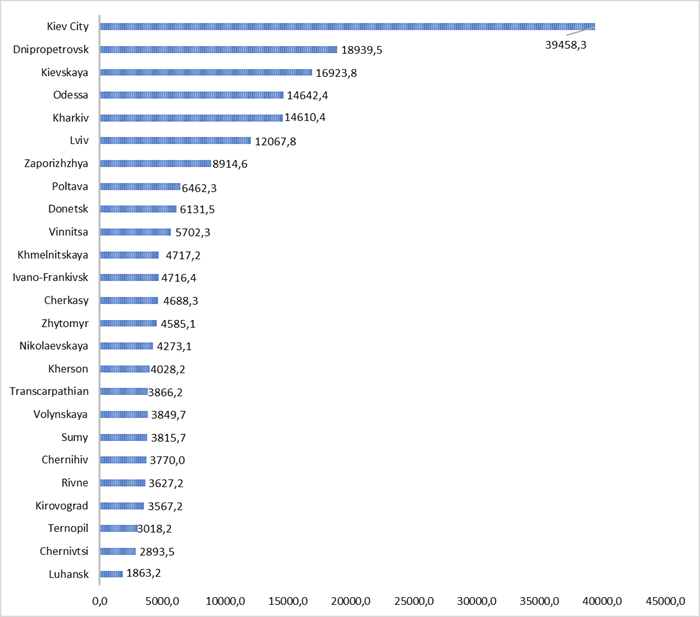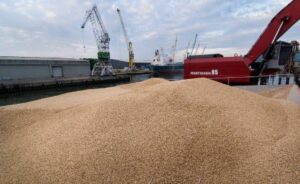Retail turnover in Ukraine by regions in Jan-feb 2021 (UAH mln)


Metallurgical plant Azovstal (Mariupol, Donetsk region), part of Metinvest Group, in January-April of this year increased the production of general rolled goods, according to recent data, by 6.8% compared to the same period last year, to 1.37 million tonnes.
A representative of the enterprise informed Interfax-Ukraine that during this period steel production increased by 7.1%, to 1.45 million tonnes, output of pig iron – by 6.2%, to 1.28 million tonnes.
In April, Azovstal produced about 370,000 tonnes of general rolled products, 400,000 tonnes of steel, and 340,000 tonnes of pig iron.
In 2020, Azovstal increased output of general rolled products by 2.7% compared to the previous year, to 3.9 million tonnes, steel by 4.5% – to 4.2 million tonnes, pig iron by 9.4% – to 3.8 million tonnes.
The company is part of Metinvest Group, the main shareholders of which are SCM Group (71.24%) and Smart-Holding (23.76%), jointly managing the company.
Metinvest Holding LLC is the management company of Metinvest Group.

Ukraine since the beginning of the 2020/2021 marketing year (MY, July-June) and as of May 7, 2021 had exported 39.24 million tonnes of grain and legumes, which is 23.6% less than on the same date of the previous MY.
According to the information and analytical portal of the agro-industrial complex of Ukraine, 15.14 million tonnes of wheat, 19.36 million tonnes of corn, 4.12 million tonnes of barley have been exported to date.
As of the indicated date, 107,000 tonnes of flour were also exported.
According to the Ministry of Agrarian Policy and Food, Ukraine exported 56.72 million tonnes of grain and leguminous crops in the 2019/2020 MY.
As reported, the Ministry of Economic Development, Trade and Agriculture of Ukraine in February predicted a decline in exports of grains and legumes in the 2020/2021 MY by 20.5% compared to the previous MY, to 45.4 million tonnes.

U.S. Secretary of State Antony Blinken believes that his talks in Kyiv with Ukrainian officials during his visit to Ukraine were productive.
“Productive time spent in Kyiv with President Zelensky and all those with whom I met,” he said on Twitter.
The Secretary of State noted that “the United States is resolute in the face of Russian aggression and in our support for the reform work needed to ensure a sovereign, democratic, and prosperous future for Ukraine.”
During a two-day visit to Kyiv, Blinken met and held talks with President Volodymyr Zelensky, Prime Minister Denys Shmyhal and Foreign Minister Dmytro Kuleba.

The international project Odessa Wine Week – a series of events focusing on key areas of development of the wine market and enogastronomic tourism will be held for the first time in Odessa from 18 to 23 May 2021.
Odessa Wine Week unites the efforts of the Ukrainian wine community, aimed at promoting and promoting the brand “Ukrainian wine”, the creation of a wine business card of Ukraine, the integration of Ukraine into the world wine community.
Odessa Wine Week events will bring together leading wine experts, scientists, oenologists, winemakers, government officials, national and foreign wine associations, tourism industry, HoReCa, retail, sommelier, wine traders, producers of related products and technologies, marketers, guilty experts, journalists.
The program includes events of various orientations: branch, cross-branch, educational, mass.
Event formats: offline, online, hybrid (offline + online); live broadcasts.
Odessa Wine Week speakers represent Ukraine, France, Italy, Spain, Austria, USA, Argentina, China.
In particular, the program includes famous winemakers Lenz Moser (“Chateau Changyu Moser XV”), Frederic Frank (“Dr. Konstantin Frank Winery”), Ricardo F. Nunez (“Vinos de La Luz”), Roberto Chipresso (“Winecircus”) ), Olga Bussinello (Consortium for the Protection of Valpolicella Wines), leading French scientists – oenologists and microbiologists Stephane Badé, Jean-Philippe Robbie, Guillermo Martins.
Odessa Wine Week partners are actively involved in the program – leading Ukrainian industry brands and organizations: SHABO, TM Koblevo, JMJ Oak Alternative, TM ODESSA champagne of Ukraine, the project “Roads of wine and taste”, the Association of winegrowers and winemakers of Odessa region , Frumushika-Nova.
Odessa Wine Week locations :
▪ Premier Hotel Odesa – conference halls “Sapphire”, “Onyx”, “Aquamarine”; Mare DiVino restaurant; Roof Bar
▪ Laboratory of Sensory Analysis of the Odessa National Academy of Food Technologies (ONAHT)
▪ Odessa film studio
Online platforms: Facebook, Youtube.
Odessa Wine Week events (according to the calendar principle):
► All-Ukrainian tasting competition “Odessa Wine & Spirit Awards”
■ May 18, 19: work of the tasting commission.
Laboratory of sensory analysis of the Odessa National Academy of Food Technologies
Offline with live broadcast on YouTube channel.
Awards of the competition:
Gold medal (86-95.5 points); Silver medal (82-85.99 points); Diploma of the contestant.
The winners of the competition have the right to place the logo of the award on the product label.
► International Symposium 2021 OENOVITI International Network
May 18, 19, 20. Online (Zoom).
“Challenges in viticulture and oenology: geographical indications of wines and wine tourism, authenticity, innovation.”
Participants – scientists from 15 countries.
OENOVITI International Network (OIN) is a unique international community of researchers in the field of viticulture and winemaking.
Ukraine has been represented in this prestigious scientific institution since 2015 by the Odessa National Academy of Food Technologies.
► Conference “Innovative tools in viticulture in the context of climate change”
May 19, 10.30-15.30. Premier Hotel Odesa, Sapphire Conference Hall.
Offline + online
Top topic: “Ensuring sustainable viticulture, current problems and ways to solve them.”
► Author’s tastings from OWW guests and partners for HoReCa and retail representatives
May 19, 12.00-15.00, Premier Hotel Odesa, Mare DiVino restaurant
► Wine talks “The future of wine: the view of winemakers”
May 19, 16.00-18.00. Premier Hotel Odesa, Onyx Conference Hall.
Offline + online
Meeting with famous winemakers, guests and OWW partners.
Обладнання та технології для виноробної та алкогольної промисловості; експозиції виноробних компаній.
► Circular tastings from OWW partners and participants
May 19, 15.30-18.30, Premier Hotel Odesa, Roof Bar
The wines of the participants of the All-Ukrainian tasting competition “Odessa Wine & Spirit Awards” and the finalists of the project “Best Riedel glass for Odessa Black variety” are presented in circular tastings.
► OWW exposure area
May 19, 20, 10.00-18.00, Premier Hotel Odesa.
► Wine Future Forum
May 20, 9.30-18.00, Premier Hotel Odesa, Sapphire Conference Hall
Offline + online
▪ State, grant, banking programs to support winemaking. Investment in winemaking. Experience of Argentina, Italy.
▪ Digital wine marketing and social media.
▪ Promotion of the Ukrainian wine brand. Creating a wine business card of Ukraine.
► Project “Best Riedel glass for Odessa Black variety”
Selection of the optimal Riedel glass for local wine Odessa Black.
The project aims to promote the brand “Ukrainian wine”, the formation of the image of Odessa Black wine / Odessa Black as a business card of Ukrainian winemaking in the world – by analogy with Saperavi (Georgia), Fetyasca (Moldova), Malbec (Argentina), Carmener (Chile), Shiraz ( Australia) and others.
● The first stage. It took place on April 22 at the ONAHT Sensory Analysis Laboratory. Competitive selection of wines, tasting of 32 samples. 10 wines passed to the second stage.
● The second stage. Selection of the optimal Riedel glass for Odessa Black wine, work of the expert commission – May 20, 10.00-14.00, Premier Hotel Odesa, Mare DiVino restaurant.
► Solemn ceremony of awarding the winners of the tasting competition “Odessa Wine & Spirit Awards” and participants and winner of the project “Best Riedel glass for Odessa Black variety”
May 20, 18.30-20.00, Premier Hotel Odesa, Aquamarine Conference Hall.
In order to disseminate information about the best Ukrainian wines, the awards will be held in the form of a spectacular ceremony with the participation of national and regional media, wine and business communities.
► Conference “Food and wine tourism – a driver for the development of tourist destinations”
May 21, 10.00-18.00, Premier Hotel Odesa, Aquamarine Conference Hall.
Offline + online
▪ Food and wine tourism – a growing sector of the world tourism market:
– Cases of the UNESCO Gastronomy Bridge.
– Wine is a driver of the region’s development. Bordeaux experience.
▪ Odessa cuisine is a tourist magnet of the region.
▪ Wine and tourism: the best examples of local projects. Presentations of wine and enogastronomic locations.
▪ The influence of the media on the creation of a positive tourist image of the region. Oenogastronomic journalism.
▪ Grant projects in the field of enogastronomic tourism. “Roads of wine and taste of Ukraine”.
► “Air tasting”
May 22, 12.00-14.00, Odessa airport.
Air travel with tasting on board the UIA plane of the top 5 Ukrainian wines – winners of the All-Ukrainian tasting competition “Odessa Wine & Spirit Awards”, as well as culinary specialties of Odessa and Bessarabian cuisine.
A joint project of Odessa Wine Week and UIA to promote the Ukrainian wine brand.
https://inlnk.ru/rJJ70
► XI gastronomic festival “Yes, delicious”
May 22, 23, 11.00-20.00, Odessa Film Studio.
A two-day festival, the participants of which present branded culinary products and wine brands. The basis of the festival menu are dishes and drinks of local Odessa cuisine. The festival is accompanied by an entertainment program for the whole family.
Large selection of delicious food, excellent conditions for outdoor recreation, live music and shows on the festival stage, entertainment program on the “Territory of children’s games and creativity”, original photo areas.
The festival is very popular with residents of Odessa and guests of the city, is held in Odessa for the eleventh time. https://www.facebook.com/takidavkusno
More about each event and conditions of visit: https://odessawineweek.com/
Project news https://www.facebook.com/odessawineweek/
***
Official support
▪ Odessa Regional State Administration
▪ Odessa City Council
Authors of the Odessa Wine Week concept:
▪ Expo-South-Service Company
▪ Odessa National Academy of Food Technologies
Odessa Wine Week organizers:
▪ Expo-South-Service Company
▪ Odessa National Academy of Food Technologies
▪ Public Union UKRSADVINPROM
General partner: SHABO company
Official partner hotel: Premier Hotel Odesa
Innovation partner: AGSOLCO Ukraine
General news partner: Interfax-Ukraine
General media partner: communicative media group Drinks +
Partners:
▪ TM “Koblevo”
▪ JMJ Oak Alternative
▪ TM ODESSA champagne of Ukraine
▪ Wine and Taste Roads Project
▪ Association of winegrowers and winemakers of Odessa region
▪ Frumushika-Nova
Scientific partner: NSC “Institute of Viticulture and Enology. VE Tairov »
Digital партнер: Gustoslife
Information partners:
▪ Wine Guide of Ukraine Project
▪ Technology and Innovation Media Group
▪ Open4Business.com.ua
Multimedia partner: “Core”
Printing partner: printing house “ALPHA PRESS”
Information support:
▪ Interlingua foreign language courses
▪ «Easy Quizzy»
Organizer of the conference “Food and wine tourism – a driver of tourist destinations”: Department of Culture and Tourism of Odessa City Council
Organizers of the project “Best Riedel glass for Odessa Black variety”:
▪ RIEDEL Company
▪ MIRS Corporation is the official distributor of RIEDEL in Ukraine
▪ Odessa National Academy of Food Technologies
▪ IKPMG Limited, Maria Kalenska
Organizers of the OENOVITI International Network symposium:
Odessa National Academy of Food Technologies, Ukraine
OENOVITI International Network, Bordeaux, France
Conference organizer “Innovative tools in viticulture in the context of climate change”: public union UKRSADVINPROM